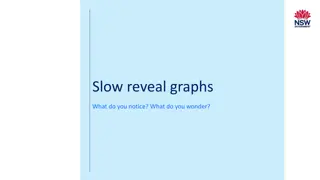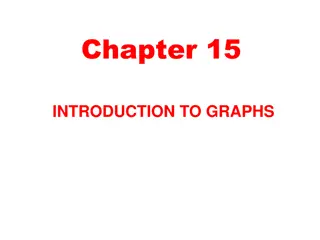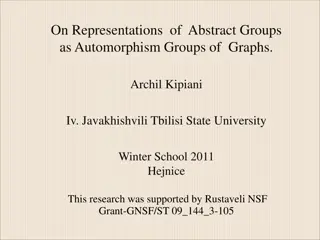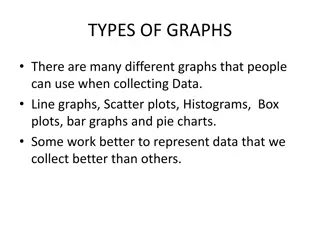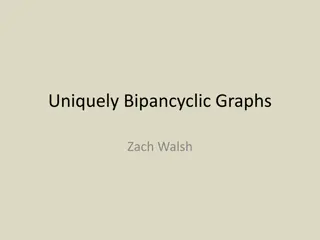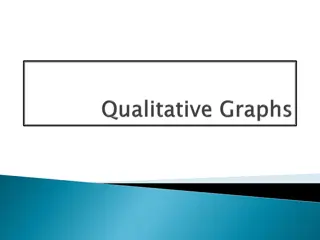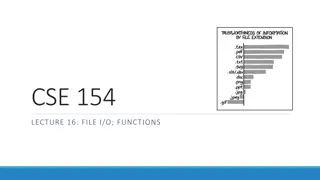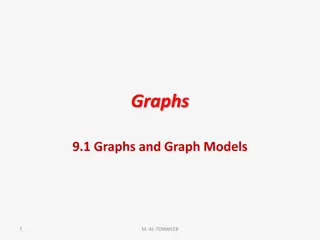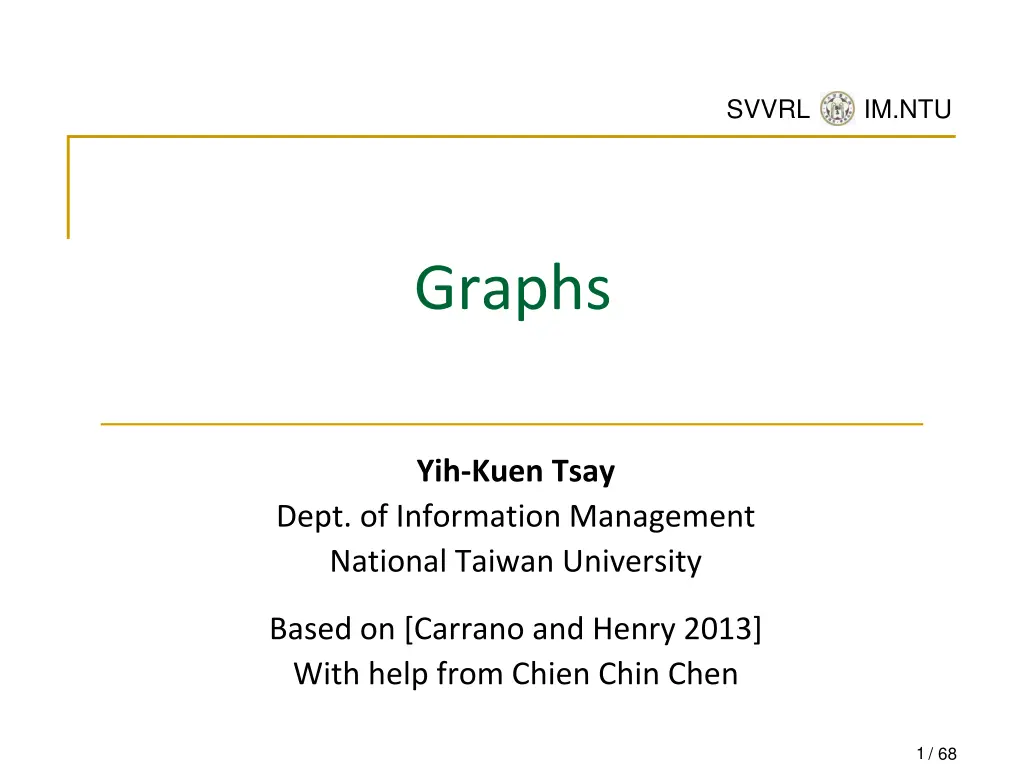
Understanding Graphs in Information Management at National Taiwan University
Explore the concepts and terms related to graphs in information management, as explained by Yih-Kuen Tsay from the Department of Information Management at National Taiwan University. Topics include graph structures, paths, cycles, connectivity, multigraphs, and weighted graphs. Images and explanations are based on the work of Carrano and Henry (2013).
Uploaded on | 0 Views
Download Presentation

Please find below an Image/Link to download the presentation.
The content on the website is provided AS IS for your information and personal use only. It may not be sold, licensed, or shared on other websites without obtaining consent from the author. If you encounter any issues during the download, it is possible that the publisher has removed the file from their server.
You are allowed to download the files provided on this website for personal or commercial use, subject to the condition that they are used lawfully. All files are the property of their respective owners.
The content on the website is provided AS IS for your information and personal use only. It may not be sold, licensed, or shared on other websites without obtaining consent from the author.
E N D
Presentation Transcript
SVVRL @ IM.NTU Graphs Yih-Kuen Tsay Dept. of Information Management National Taiwan University Based on [Carrano and Henry 2013] With help from Chien Chin Chen 1 / 68
SVVRL @ IM.NTU Concepts and Terms (1/8) Graphs provide a way to illustrate data and have significant applications in many fields. We will consider the kind of graphs with points that are joined by lines, like in a line graph. An ordinary line graph Source: FIGURE 20-1 in [Carrano and Henry 2013]. Yih-Kuen Tsay DS 2017: Graphs 2 / 68
SVVRL @ IM.NTU Concepts and Terms (2/8) A graph G = (V, E) consists of two sets: A set V of vertices, or nodes. A set E of edges , or links, that connect the vertices. A subgraph consists of a subset of a graph s vertices and a subset of its edges (connecting the vertices in the selected subset of vertices). Two vertices are adjacent it they are joined by an edge. Yih-Kuen Tsay DS 2017: Graphs 3 / 68
SVVRL @ IM.NTU Concepts and Terms (3/8) (a) A campus map as a graph; (b) a subgraph Source: FIGURE 20-2 in [Carrano and Henry 2013]. Yih-Kuen Tsay DS 2017: Graphs 4 / 68
SVVRL @ IM.NTU Concepts and Terms (4/8) A path is a sequence of edges that begins at one vertex and ends at another vertex. A path may pass through the same vertex more than once. A simple path is a path that passes through a vertex at most once. A cycle is a path that begins and ends at the same vertex. A simple cycle is a cycle that does not pass through other vertices more than once. Yih-Kuen Tsay DS 2017: Graphs 5 / 68
SVVRL @ IM.NTU Concepts and Terms (5/8) A graph is connected if each pair of distinct vertices has a path between them (e.g., (a)); it is disconnected, otherwise (e.g., (b)). A graph is complete if each pair of distinct vertices has an edge between them. Source: FIGURE 20-3 in [Carrano and Henry 2013]. Yih-Kuen Tsay DS 2017: Graphs 6 / 68
SVVRL @ IM.NTU Concepts and Terms (6/8) A multigraph allows multiple edges between vertices. By definition, a multipgraph is not a (simple) graph. (Most definitions of a simple graph allow self loops.) Special kinds of graphs: (a) a multigraph; (b) a node with a self loop Source: FIGURE 20-4 in [Carrano and Henry 2013]. Yih-Kuen Tsay DS 2017: Graphs 7 / 68
SVVRL @ IM.NTU Concepts and Terms (7/8) Weighted graph A graph whose edges have numeric labels. Undirected graph Edges do not indicate a direction. Directed graph (digraph) Each edge has a direction, and is called a directed edge. A digraph may have two edges between a pair of vertices, one in each direction. Vertex y is adjacent to vertex x if there is a directed edge from x to y. A directed path is a sequence of directed edges between two vertices. Yih-Kuen Tsay DS 2017: Graphs 8 / 68
SVVRL @ IM.NTU Concepts and Terms (8/8) (a) A weighted graph; (b) a directed graph Source: FIGURE 20-5 in [Carrano and Henry 2013]. Yih-Kuen Tsay DS 2017: Graphs 9 / 68
SVVRL @ IM.NTU Graphs as ADTs (1/6) Variations of an ADT graph are possible Vertices may or may not contain values. Many problems have no need for vertex values. Relationships among vertices is what is important. Either directed or undirected edges. Either weighted or unweighted edges. Insertion and deletion operations for graphs apply to vertices and edges. Graphs can have traversal operations. Yih-Kuen Tsay DS 2017: Graphs 10 / 68
SVVRL @ IM.NTU Graphs as ADTs (2/6) Operations: Insert a vertex in a graph. Test whether a graph is empty. Insert an edge between two given vertices. Get the number of vertices in a graph. Delete a particular vertex from a graph. Get the number of edges in a graph. Delete the edge between two given vertices. Determine whether an edge exists between two given vertices. Retrieve the vertex that contains a given search key. Also, traverse the graph. Yih-Kuen Tsay DS 2017: Graphs 11 / 68
SVVRL @ IM.NTU Graphs as ADTs (3/6) /** An interface for the ADT undirected, connected (?) graph. @file GraphInterface.h */ #ifndef _GRAPH_INTERFACE #define _GRAPH_INTERFACE template<class LabelType> class GraphInterface { public: /** Gets the number of vertices in this graph. @pre None. @return The number of vertices in the graph. */ virtual int getNumVertices() const = 0; /** Gets the number of edges in this graph. @pre None. @return The number of edges in the graph. */ virtual int getNumEdges() const = 0; 12 Yih-Kuen Tsay DS 2017: Graphs / 68
SVVRL @ IM.NTU Graphs as ADTs (4/6) /** Creates an undirected edge in this graph between two vertices that have the given labels. If such vertices do not exist, creates them and adds them to the graph before creating the edge. @param start A label for the first vertex. @param end A label for the second vertex. @param edgeWeight The integer weight of the edge. @return True if the edge is created; false, otherwise. */ virtual bool add(LabelType start, LabelType end, int edgeWeight) = 0; /** Removes an edge from this graph. If a vertex has no other edges, it is removed from the graph since this is a connected graph. @pre None. @param start A label for the first vertex. @param end A label for the second vertex. @return True if the edge is removed; false, otherwise. */ virtual bool remove(LabelType start, LabelType end) = 0 13 Yih-Kuen Tsay DS 2017: Graphs / 68
SVVRL @ IM.NTU Graphs as ADTs (5/6) /** Gets the weight of an edge in this graph. @return The weight of the specified edge. If no such edge exists, returns a negative integer. */ virtual int getEdgeWeight(LabelType start, LabelType end) const = 0; /** Performs a depth-first search of this graph beginning at the given vertex and calls a given function once for each vertex visited. @param start A label for the first vertex. @param visit A client-defined function that performs an operation on or with each visited vertex. */ virtual void depthFirstTraversal(LabelType start, void visit(LabelType&)) = 0; 14 Yih-Kuen Tsay DS 2017: Graphs / 68
SVVRL @ IM.NTU Graphs as ADTs (6/6) /** Performs a breadth-first search of this graph beginning at the given vertex and calls a given function once for each vertex visited. @param start A label for the first vertex. @param visit A client-defined function that performs an operation on or with each visited vertex. */ virtual void breadthFirstTraversal(LabelType start, void visit(LabelType&)) = 0; }; // end GraphInterface #endif 15 Yih-Kuen Tsay DS 2017: Graphs / 68
SVVRL @ IM.NTU Representing Graphs (1/9) Two most common representations of a graph: Adjacency matrix Adjacency list An adjacency matrix for a graph with n vertices numbered 0, 1, , n 1 is an n by n array matrix such that matrix[i][j] indicates whether an edge exists from vertex i to vertex j. An adjacency list for a graph with n vertices numbered 0, 1, , n 1 is an array of n linked lists, where the i-th linked list has a node for vertex j if and only if an edge exists from vertex i to vertex j. Yih-Kuen Tsay DS 2017: Graphs 16 / 68
SVVRL @ IM.NTU Representing Graphs (2/9) The adjacency matrix for an undirected graph is symmetrical; that is, matrix[i][j] equals matrix[j][i]. For an unweighted graph, matrix[i][j] is 1 (or true) if an edge exists from vertex i to vertex j, or 0 (or false) if no edge exists from vertex i to vertex j. For a weighted graph, matrix[i][j] is the weight of the edge from vertex i to vertex j, or if no edge exists from vertex i to vertex j. Yih-Kuen Tsay DS 2017: Graphs 17 / 68
SVVRL @ IM.NTU Representing Graphs (3/9) (a) A directed graph and (b) its adjacency matrix Source: FIGURE 20-6 in [Carrano and Henry 2013]. Yih-Kuen Tsay DS 2017: Graphs 18 / 68
SVVRL @ IM.NTU Representing Graphs (4/9) (a) A weighted graph and (b) its adjacency matrix Source: FIGURE 20-7 in [Carrano and Henry 2013]. Yih-Kuen Tsay DS 2017: Graphs 19 / 68
SVVRL @ IM.NTU Representing Graphs (5/9) In the adjacency list for a graph with n vertices numbered 0, 1, , n 1, the i-th list s node can contain: Vertex j s value, if any, or an indication of vertex j s identity, Edge weight, and A pointer pointing to the next node. In the adjacency list for an undirected graph, each edge is treated as if it were two directed edges in opposite directions. Yih-Kuen Tsay DS 2017: Graphs 20 / 68
SVVRL @ IM.NTU Representing Graphs (6/9) (a) A directed graph and (b) its adjacency list Source: FIGURE 20-8 in [Carrano and Henry 2013]. Yih-Kuen Tsay DS 2017: Graphs 21 / 68
SVVRL @ IM.NTU Representing Graphs (7/9) (a) A weighted graph and (b) its adjacency list Note that each edge is treated as if it were two directed edges in opposite directions. Source: FIGURE 20-9 in [Carrano and Henry 2013]. Yih-Kuen Tsay DS 2017: Graphs 22 / 68
SVVRL @ IM.NTU Representing Graphs (8/9) Which of these two representations is better? Depends on how your application uses the graph. Two common operations on graphs: Check whether there is an edge from vertex i to vertex j. Find all vertices adjacent to a given vertex i. 1. 2. The case of adjacency matrix: Supports operation 1 more efficiently. Only need to examine the value of matrix[i][j]. The case of adjacency list: Supports operation 2 more efficiently. Traverse the ithlinked list. Yih-Kuen Tsay DS 2017: Graphs 23 / 68
SVVRL @ IM.NTU Representing Graphs (9/9) Space requirements of the two representations: The adjacency matrix always has n2entries. The number of nodes in an adjacency list equals the number of edges in a graph (twice for an undirected graph). Each node contains both a value and a pointer. The list also has n head pointer. Often requires less space than an adjacency matrix. In summary, you must consider: What operations are needed. Memory requirements (the number of edges). Yih-Kuen Tsay DS 2017: Graphs 24 / 68
SVVRL @ IM.NTU Graph Traversals (1/3) A graph traversal visits all the vertices that it can reach by following edges, from a given vertex. A traversal that starts at vertex v will visit all vertices w for which there is a path between v and w. A traversal visits all vertices of the graph if and only if the graph is connected. If a graph is not connected, a graph traversal will visit only a subset of the graph s vertices. The subset of vertices visited during a traversal that begins at a given vertex is called a connected component. Yih-Kuen Tsay DS 2017: Graphs 25 / 68
SVVRL @ IM.NTU Graph Traversals (2/3) If a graph contains a cycle, a graph-traversal algorithm may loop indefinitely. To prevent indefinite loops, Mark each vertex during a visit, and Never visit a vertex more than once. Two basic graph-traversal strategies (algorithms): depth-first search (DFS) and breadth-first search (BFS). Both DFS and BFS can apply to either directed or undirected graphs. Yih-Kuen Tsay DS 2017: Graphs 26 / 68
SVVRL @ IM.NTU Graph Traversals (3/3) (a) A depth-first search (DFS); (b) a breadth-first search (BFS) Source: FIGURE 20-10 in [Carrano and Henry 2013]. Yih-Kuen Tsay DS 2017: Graphs 27 / 68
SVVRL @ IM.NTU DFS Traversal (1/7) From a given vertex v, DFS proceeds along a path from v as deeply into the graph as possible before backing up. It has a simple recursive form: // Traverses a graph beginning at vertex v by using a // depth-first search: Recursive version. dfs(v: Vertex) Mark v as visited for (each unvisited vertex u adjacent to v) dfs(u) Yih-Kuen Tsay DS 2017: Graphs 28 / 68
SVVRL @ IM.NTU DFS Traversal (2/7) dfs(v: Vertex) Mark v as visited for (each unvisited vertex u adjacent to v) dfs(u) 1 dfs(v) v v dfs(w) dfs(x) 2 7 8 u u w w x x dfs(u) 6 3 q q t t dfs(q) dfs(t) 4 5 dfs(r) dfs(s) r r s s Yih-Kuen Tsay DS 2017: Graphs 29 / 68
SVVRL @ IM.NTU DFS Traversal (3/7) DFS is a last visited, first explored strategy. It has an iterative form that uses a stack. dfs(v: Vertex) s = a new empty stack s.push(v) Mark v as visited while (!s.isEmpty()) { if (no unvisited vertices are adjacent to the vertex on the top of the stack) s.pop() // Backtrack else { Select an unvisited vertex u adjacent to the vertex on the top of the stack s.push(u) Mark u as visited } } Yih-Kuen Tsay DS 2017: Graphs 30 / 68
SVVRL @ IM.NTU DFS Traversal (4/7) 1 v v dfs(v) 8 2 7 u u w w x x r s q t 6 3 u w x q q t t v stack 4 5 r r s s Yih-Kuen Tsay DS 2017: Graphs 31 / 68
SVVRL @ IM.NTU DFS Traversal (5/7) A connected graph with cycles Source: FIGURE 20-11 in [Carrano and Henry 2013]. Yih-Kuen Tsay DS 2017: Graphs 32 / 68
SVVRL @ IM.NTU DFS Traversal (6/7) 2 1 3 9 6 8 4 5 7 A depth-first traversal of the graph in Figure 20-11 Source: FIGURE 20-11 in [Carrano and Henry 2013]. Yih-Kuen Tsay DS 2017: Graphs 33 / 68
SVVRL @ IM.NTU DFS Traversal (7/7) A depth-first traversal of the graph in Figure 20-11 Source: FIGURE 20-12 in [Carrano and Henry 2013]. Yih-Kuen Tsay DS 2017: Graphs 34 / 68
SVVRL @ IM.NTU BFS Traversal (1/4) BFS visits every vertex adjacent to a vertex v that it can before visiting any other vertex. It is a first visited, first explored strategy, and can be implemented in an iterative form, using a queue. bfs(v: Vertex) q = a new empty queue q.enqueue(v) Mark v as visited while (!q.isEmpty()) { w = q.peekFront() q.dequeue() for (each unvisited vertex u adjacent to w) { Mark u as visited q.enqueue(u) } } Yih-Kuen Tsay DS 2017: Graphs 35 / 68
SVVRL @ IM.NTU BFS Traversal (2/4) 1 v v bfs(v) 3 4 2 u u w w x x 6 5 q q t t 7 8 r r s s queue v u w x q t r s Yih-Kuen Tsay DS 2017: Graphs 36 / 68
SVVRL @ IM.NTU BFS Traversal (3/4) 2 1 5 4 6 9 8 7 3 A breadth-first traversal of the graph in Figure 20-11 Source: FIGURE 20-11 in [Carrano and Henry 2013]. Yih-Kuen Tsay DS 2017: Graphs 37 / 68
SVVRL @ IM.NTU BFS Traversal (4/4) A breadth-first traversal of the graph in Figure 20-11 Source: FIGURE 20-13 in [Carrano and Henry 2013]. Yih-Kuen Tsay DS 2017: Graphs 38 / 68
SVVRL @ IM.NTU Topological Sorting (1/6) Topological order: A list of vertices in a directed graph without cycles (like the one below) such that vertex x precedes vertex y if there is a directed edge from x to y in the graph. A directed graph without cycles Source: FIGURE 20-14 in [Carrano and Henry 2013]. Yih-Kuen Tsay DS 2017: Graphs 39 / 68
SVVRL @ IM.NTU Topological Sorting (2/6) Several topological orders are possible for a given graph. The graph in Fig. 20-14 arranged in two different topological orders Source: FIGURE 20-15 in [Carrano and Henry 2013]. Yih-Kuen Tsay DS 2017: Graphs 40 / 68
SVVRL @ IM.NTU Topological Sorting (3/6) Topological sorting: Arranging the vertices into a topological order. topSort1 1. Find a vertex that has no successor. 2. Add the vertex to the beginning of a list. 3. Remove that vertex from the graph, as well as all edges that lead to it. 4. Repeat the previous steps until the graph is empty. When the loop ends, the list of vertices will be in topological order. Yih-Kuen Tsay DS 2017: Graphs 41 / 68
SVVRL @ IM.NTU Topological Sorting (4/6) a b c d e f g a g d b e c f List: Yih-Kuen Tsay DS 2017: Graphs 42 / 68
SVVRL @ IM.NTU Topological Sorting (5/6) topSort2(theGraph: Graph, aList: list) s = a new empty stack for (each vertex v in theGraph) if (v has no predecessors) { s.push(v) Mark v as visited } while (!s.isEmpty()) { if (all vertices adjacent to the vertex on the top of the stack have been visited) { s.pop(v) aList.insert(1, v) } else { Select an unvisited vertex u adjacent to the vertex on the top of the stack s.push(u) Mark u as visited } } Yih-Kuen Tsay DS 2017: Graphs 43 / 68
SVVRL @ IM.NTU Topological Sorting (6/6) a a b b c c c f e d d d e e f f g b a g g f a b g d e c List: stack Push (and mark) all vertices that have no predecessor onto a stack. DFS while loop 1. 2. Yih-Kuen Tsay DS 2017: Graphs 44 / 68
SVVRL @ IM.NTU Spanning Trees (1/7) A tree is an undirected connected graph without cycles. A spanning tree of a connected undirected graph G is a subgraph of G that contains all of G s vertices and enough of its edges to form a tree. Yih-Kuen Tsay DS 2017: Graphs 45 / 68
SVVRL @ IM.NTU Spanning Trees (2/7) There may be several spanning trees for a given graph. To obtain a spanning tree from a connected undirected graph with cycles, one may remove edges until there are no cycles. Detecting a cycle in an undirected connected graph: A connected undirected graph that has n vertices must have at least n 1 edges. A connected undirected graph that has n vertices and exactly n 1 edges cannot contain a cycle. A connected undirected graph that has n vertices and more than n 1 edges must contain at least one cycle. You can determine whether a connected graph contains a cycle simply by counting its vertices and edges. Yih-Kuen Tsay DS 2017: Graphs 46 / 68
SVVRL @ IM.NTU Spanning Trees (3/7) Two algorithms for determining a spanning tree of a graph: The DFS spanning tree. THE BFS spanning tree. DS 2017: Graphs 47 / 68 Yih-Kuen Tsay
SVVRL @ IM.NTU Spanning Trees (4/7) To create a depth-first search (DFS) spanning tree, Traverse the graph using a depth-first search and mark the edges that you follow. After the traversal is complete, the graph s vertices and marked edges form the spanning tree. To create a breath-first search (BFS) spanning tree, Traverse the graph using a bread-first search and mark the edges that you follow. When the traversal is complete, the graph s vertices and marked edges form the spanning tree. Yih-Kuen Tsay DS 2017: Graphs 48 / 68
SVVRL @ IM.NTU Spanning Trees (5/7) A DFS spanning tree for the graph in Fig. 20-11 Source: FIGURE 20-20 in [Carrano and Henry 2013]. Yih-Kuen Tsay DS 2017: Graphs 49 / 68
SVVRL @ IM.NTU Spanning Trees (6/7) The DFS spanning tree rooted at vertex a. root (1) a a b b (2) e f (8) g h c c d h h (3) i i e e c (7) (5) b i d d a (6) f f g g (4) stack Yih-Kuen Tsay DS 2017: Graphs 50 / 68





